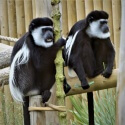
Eastern Black and White Colobus Natural History
Size
The head and body length of these monkeys is around 24 inches (61 cm), plus the same again in their tail, with a total weight of up to 30 lbs (13.5 kg).
Habitat and Distribution
This species lives in all manner of forest types throughout it’s range of Nigeria, Cameroon, Gabon, South Sudan, and Uganda.
Age
In the wild these primates can have a lifespan of up to 20 years but can live until they’re 30 in captivity.
Diet
They are herbivores feeding predominantly on leaves. The plants in their diet would be toxic to many other primates so they have several sections in the stomachs to help with their digestion.
Groups and Breeding
This species lives in groups of up to 15 individuals made up of one adult male with the rest of the group being females and their young. Females invite males to mate by tongue smacking and usually give birth to one young after a 6 month gestation period. Females reach maturity at the age of 4-5 and will remain in their native groups. However, males don’t reach maturity until they are 6-8 years of age and will be chased away from the group by the dominant male.
Threats and Conservation
This is a fairly common species. However, it is in decline as a result of logging. The main effect of logging on this species is that it is hunted for meat by the loggers and for its fur as a secondary income.
Interesting Facts
Baby colobus are born white, gradually turning black with age.
Eastern Black and White Colobus During your Day out in Kent
Our bachelor group of Eastern black and White Colobus are located behind the Dinosaur Zoo. They are in the middle of three exhibits within our new Rainforest SOS area which celebrates rainforests and highlights issues surrounding deforestation. Their names are Rupert, Reggie, Ronnie and Roger.
Here at Wingham Wildlife Park their diet consists of vegetables, browse, shelled nuts, insects, leaf-eater pellets and boiled eggs.
The more you know…
Want to know more about this animal? Check out our keeper blogs about them here.